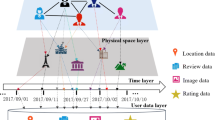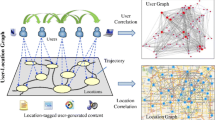Abstract
During the last decade, in parallel with the rapid growth of mobile communications and devices, location-based social networks have met a tremendous growth with the acceptance of the public being constantly increasing. Users have access to a plethora of venues and points of interest, while they are able to share their visits to various locations along with comments and ratings about their experience (a process which is often referred to as “check-ins”). Location recommendations based on users’ needs have been a subject of interest for many researchers, while location prediction schemes have been developed in order to provide user’s possible future locations. In this paper, we present a novel method for predicting a user’s location based on machine learning techniques. In addition, following the incremental trend towards data accumulation in social networks, we introduce a clustering based prediction method in order to enhance the recommender system. For the prediction process we propose a probabilistic neural network and confirm its superior performance against two other types of neural networks, while for the clustering process we use a K-means clustering algorithm. The dataset we used was based on input from a well-known location-based social network. Prediction results can be used in order to make appropriate suggestions for venues or points of interests to users, based on their interests and social connections.













Similar content being viewed by others
References
Basu C, Hirsh H, Cohen W, et al. (1998) Recommendation as classification: Using social and content-based information in recommendation. In: AAAI/IAAI. pp 714–720
Bianchini M, Frasconi P, Gori M (1995) Learning without local minima in radial basis function networks. Neural Netw IEEE Trans 6(3):749–756
Celeux G, Govaert G (1992) A classification em algorithm for clustering and two stochastic versions. Comput Stat Data Anal 14(3):315–332
Chen S, Hong X, Harris CJ (2005) Orthogonal forward selection for constructing the radial basis function network with tunable nodes. In: Advances in Intelligent Computing. Springer, pp 777–786
Chen X, Zeng Y, Cong G, Qin S, Xiang Y, Dai Y (2015) On information coverage for location category based point-of-interest recommendation. In: Twenty-Ninth AAAI Conference on Artificial Intelligence. pp 37–43
Cheng C, Yang H, King I, Lyu M R (2012) Fused matrix factorization with geographical and social influence in location-based social networks. In: Twenty-Sixth AAAI Conference on Artificial Intelligence. pp 17–23
Cordeiro R (2008) Constrained intelligent k-means: improving results with limited previous knowledge. In: Second international conference on advanced engineering computing and applications in sciences. IEEE, pp 176–180
Cristianini N, Shawe-Taylor J (2000) An introduction to support vector machines and other kernel-based learning methods. Cambridge university press, Cambridge
Dempster AP, Laird NM, Rubin DB (1977) Maximum likelihood from incomplete data via the em algorithm. J R Stat Soc Ser B 39(1):1–38
Feng Y, Yu Z, Lu X, Tian J (2013) Understanding human dynamics of check-in behavior in lbsns. In: International conference on green computing and communications (GreenCom). IEEE, pp 923–930
Fukano J, Mashita T, Hara T, Kiyokawa K, Takemura H, Nishio S (2013) A next location prediction method for smartphones using blockmodels. In: Virtual Reality (VR). IEEE, pp 1–4
Gebremeskel GB, He Z, Jing X (2013) Semantic integrating for intelligent cloud data mining platform and cloud based business intelligence for optimization of mobile social networks. In: Bhatnagar V (ed), Data Mining in Dynamic Social Networks and Fuzzy Systems. IGI Global, pp 173–211
Gong Y, Li Y, Jin D, Su L, Zeng L (2011) A location prediction scheme based on social correlation. In: Vehicular Technology Conference (VTC Spring). IEEE, pp 1–5
Hamburger E (2014) The next age of foursquare begins today. The Verge, http://www.theverge.com/2014/7/23/5926843/this-is-the-new-foursquare. Accessed 12 Jan 2016
Hu G N, Dai XY, Song Y, Huang SJ, Chen JJ (2015) A synthetic approach for recommendation: combining ratings, social relations, and reviews. In: 24th international conference on artificial intelligence. AAAI Press, pp 1756–1762
Kosmides P, Remoundou C, Demestichas K, Loumiotis I, Adamopoulou E, Theologou M (2014) A location recommender system for location-based social networks. In: International conference on mathematics and computers in sciences and in industry (MCSI). IEEE, pp 277–280
Levandoski JJ, Sarwat M, Eldawy A, Mokbel MF (2012) Lars: a location-aware recommender system. In: 28th International Conference on Data Engineering (ICDE). IEEE, pp 450–461
Li X, Cong G, Li XL, Pham TAN, Krishnaswamy S (2015) Rank-geofm: a ranking based geographical factorization method for point of interest recommendation. In: 38th international ACM SIGIR conference on research and development in information retrieval. ACM, pp 433–442
Lian D, Zhu Y, Xie X, Chen E (2014) Analyzing location predictability on location-based social networks. In: Advances in Knowledge Discovery and Data Mining. Springer, pp 102–113
Mathew W, Raposo R, Martins B (2012) Predicting future locations with hidden markov models. In: Conference on Ubiquitous Computing. ACM, pp 911–918
McGee J, Caverlee J, Cheng Z (2013) Location prediction in social media based on tie strength. In: 22nd international conference on information and knowledge management. ACM, pp 459–468
OpenGroup (2014) ArchiMate 2.1 Specification. The Open Group Specifications.http://pubs.opengroup.org/architecture/archimate2-doc. Accessed 12 Jan 2016
Orr M J, et al. (1996) Introduction to radial basis function networks. Technical Report, Center for Cognitive Science, University of Edinburgh
Parzen E (1962) On estimation of a probability density function and mode. Ann Math Stat 33(3):1065–1076
Pazzani MJ, Billsus D (2007) Content-based recommendation systems. In: The adaptive web. Springer, pp 325–341
Specht DF (1990) Probabilistic neural networks. Neural Netw 3(1):109–118
Wang H, Terrovitis M, Mamoulis N (2013) Location recommendation in location-based social networks using user check-in data. In: 21st SIGSPATIAL international conference on advances in geographic information systems. ACM, pp 374–383
Wang R, Chow CY, Nutanong S, Lyu Y, Li Y, Yuan M, Lee V (2014) Exploring cell tower data dumps for supervised learning-based point-of-interest prediction. In: 22nd SIGSPATIAL international conference on advances in geographic information systems. ACM, pp 457–460
Wang ZM, Yang F (2009) An optimized location-based mobile restaurant recommend and navigation system. WSEAS Trans Inf Sci Appl 6(5):809–818
Xiao X, Zheng Y, Luo Q, Xie X (2014) Inferring social ties between users with human location history. J Ambient Intel Human Comput 5(1):3–19
Yang F, Wang Z (2009) A mobile location-based information recommendation system based on gps and web2.0 services. WSEAS Trans Comput 8(4):725–734
Ye M, Yin P, Lee WC, Lee DL (2011) Exploiting geographical influence for collaborative point-of-interest recommendation. In: 34th international SIGIR conference on research and development in information retrieval. ACM, pp 325–334
Yuan Q, Cong G, Ma Z, Sun A, Thalmann N M (2013) Time-aware point-of-interest recommendation. In: 36th International SIGIR conference on research and development in information retrieval. ACM, pp 363–372
Zhang JD, Chow CY (2015) Geosoca: exploiting geographical, social and categorical correlations for point-of-interest recommendations. In: 38th international SIGIR conference on research and development in information retrieval. ACM, pp 443–452
Zhou D, Wang B, Rahimi SM, Wang X (2012) A study of recommending locations on location-based social network by collaborative filtering. In: Advances in Artificial Intelligence. Springer, pp 255–266
Author information
Authors and Affiliations
Corresponding author
Rights and permissions
About this article
Cite this article
Kosmides, P., Demestichas, K., Adamopoulou, E. et al. Providing recommendations on location-based social networks. J Ambient Intell Human Comput 7, 567–578 (2016). https://doi.org/10.1007/s12652-016-0346-7
Received:
Accepted:
Published:
Issue Date:
DOI: https://doi.org/10.1007/s12652-016-0346-7




